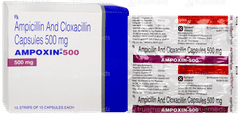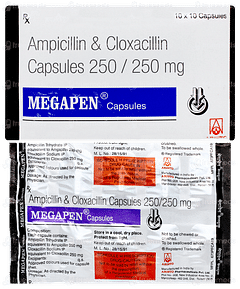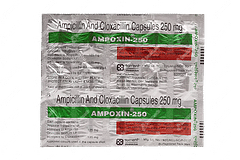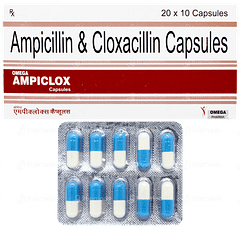Ampicillin + Cloxacillin
Uses of Ampicillin + Cloxacillin
Ampicillin + Cloxacillin is used to manage bacterial infections. It is a combination antibiotic belonging to the penicillin class of antibiotics.
It can be used to manage post-operative wound infections, post-operative pulmonary infections, bronchopneumonia, and acute exacerbations of chronic bronchitis caused by susceptible organisms. It can also be used for infections of bone, ear, nose, and throat.
Side effects of Ampicillin + Cloxacillin
Nausea
Vomiting
Diarrhea
Skin rash
How Ampicillin + Cloxacillin works
- Ampicillin + Cloxacillin is a combination antibiotic.
- Ampicillin is a beta-lactam antibiotic in the aminopenicillin class. Beta-lactam antibiotics first bind to penicillin-binding proteins (PBPs) on the bacterial cell membrane, which are essential for cell wall construction. This binding disrupts the PBPs' function, leading to the breakdown of the cell wall and causing the bacteria to burst and die. Ampicillin is primarily bactericidal, meaning it kills bacteria by inhibiting cell wall synthesis.
- Cloxacillin, a member of the penicillin class, is mainly effective against penicillinase-producing staphylococci, including Staphylococcus aureus, which commonly causes skin infections. It targets bacteria that produce the enzyme penicillinase, which can break down penicillin and make it ineffective.
Certified content
Written By

Bachelor of Dental Surgery
Reviewed By

MSc (Applied Genetics)
Expert Advice
Dosage Forms Available
- This combination is available to be taken orally (tablet, capsule, and suspension), intravenously and intramuscularly (injection and infusion).
Age and Dose Restrictions
- Ampicillin + Cloxacillin is typically prescribed for adults and children over one year of age.
Contraindications
- Avoid this combination if you are allergic to ampicillin, cloxacillin, or other penicillin or cephalosporin antibiotics.
Other Medications to Avoid
- This combination may interact with bacteriostatic antibiotics (e.g., tetracyclines and chloramphenicol), antihyperuricemics (e.g., allopurinol and probenecid), and the contraceptive pill. These medications may reduce the effectiveness of Ampicillin + Cloxacillin.
Overdose and Missed Dose
- Taking an overdose of this combination can cause symptoms like nausea, vomiting, diarrhoea, and seizures. If this happens, contact your doctor immediately.
- If you miss a dose, take it as soon as you remember. If it's almost time for your next dose, skip the missed one and resume your regular schedule.
Management of Side Effects
Most of the side effects of this combination are temporary and generally harmless. They resolve upon discontinuation of this medicine. However, if you experience any severe side effects of any of the symptoms, please consult your doctor.
- If you experience nausea or an upset stomach, it may help to take this medicine with food.
Use in Driving and Operating Machinery
- This medication may cause dizziness or fatigue in some people. If this happens, you should not drive or operate heavy machinery until these effects wear off.
Use in Pregnancy and Lactation
- Caution is advised while taking Ampicillin + Cloxacillin during pregnancy and breastfeeding.
Caution in Other Conditions
- If you have kidney problems, leukaemia, or suffer from diarrhoea after taking antibiotics, you should use this combination with caution.
Special Dietary and Lifestyle Recommendations
- While on this combination, it's advisable to steer clear of alcohol because it may heighten the likelihood of experiencing side effects such as dizziness and stomach upset.
- Maintaining a balanced diet and staying well-hydrated can help your body combat the infection.
- Engaging in regular exercise can strengthen your immune system and facilitate your recovery.
Frequently asked questions
Is Ampicillin + Cloxacillin safe for long-term use?
No, this combination is not intended for long-term use. Take it for the duration as prescribed by your doctor.
Can I take Ampicillin + Cloxacillin on an empty stomach?
It is best to take this combination on an empty stomach, usually one hour before or two hours after meals.
How long does Ampicillin + Cloxacillin stay in the body?
Both ampicillin and cloxacillin are usually eliminated from the body within 6 to 8 hours. However, this can vary depending on individual factors, including the person's age, weight, and overall health.
Can Ampicillin + Cloxacillin be used for viral infections?
No, this combination is an antibiotic and is effective only against bacterial infections. It will not work for viral infections like colds or flu.
Can Ampicillin + Cloxacillin cause constipation?
Constipation is not a typical side effect of Ampicillin + Cloxacillin. However, if you experience constipation while taking this medicine, drinking plenty of fluids and eating a high-fiber diet may help.
Can Ampicillin + Cloxacillin affect the results of some laboratory tests?
Yes, Ampicillin + Cloxacillin can interfere with certain laboratory tests, including some types of urine glucose (sugar) tests. If you're asked to provide a urine sample, make sure you tell the doctor or nurse that you're taking this medicine.
Can Ampicillin + Cloxacillin cause yeast infections?
Yes, like other antibiotics, Ampicillin + Cloxacillin can disrupt the balance of bacteria and yeast in the body, which may result in yeast infections, particularly in the mouth.
What is Ampicillin + Cloxacillin used for?
Ampicillin + Cloxacillin is used to treat bacterial infections. This combination, derivative of penicillin, works by killing bacteria and stopping their growth. It is effective for infections of the skin, urinary tract, pneumonia, dental issues, upper respiratory tract, and bones and joints.
Ampicillin + Cloxacillin in other salts
List of Medicines for Ampicillin + Cloxacillin







Company
About UsHealth ArticleHealth StoriesDiseases & Health ConditionsAyurvedaAll MedicinesAll BrandsNeed HelpFAQSecuritySubscribe
Registered Office Address
Grievance Officer
Download Truemeds
Contact Us
Our customer representative team is available 7 days a week from 9 am - 9 pm.
v4.8.0
2025 - Truemeds | All rights reserved. Our content is for informational purposes only. See additional information.
Our Payment Partners










